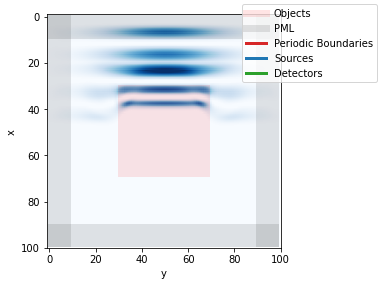04. Performance Profiling
We can profile the performance with a 3D FDTD simulation:
Imports
[1]:
import matplotlib.pyplot as plt
from line_profiler import LineProfiler
import fdtd
import fdtd.backend as bd
Set Backend
Let’s profile the impact of the backend. These are the possible backends:
numpy(defaults to float64 arrays)torch(defaults to float64 tensors)torch.float32torch.float64torch.cuda(defaults to float64 tensors)torch.cuda.float32torch.cuda.float64
[2]:
fdtd.set_backend("numpy")
In general, the numpy backend is preferred for standard CPU calculations with "float64" precision as it is slightly faster than torch backend on CPU. However, a significant performance improvement can be obtained by choosing torch.cuda on large enough grids.
Note that, in FDTD, float64 precision is generally preferred over float32 to ensure numerical stability and prevent numerical dispersion. If this is of no concern to you, you can opt for float32 precision, which especially on a GPU might yield a significant performance boost.
Constants
[3]:
WAVELENGTH = 1550e-9
SPEED_LIGHT: float = 299_792_458.0 # [m/s] speed of light
Setup Simulation
create FDTD Grid
[4]:
N = 100
grid = fdtd.Grid(
(N, N, N),
grid_spacing=0.05 * WAVELENGTH,
permittivity=1.0,
permeability=1.0,
)
add boundaries
[5]:
# x boundaries
grid[0:10, :, :] = fdtd.PML(name="pml_xlow")
grid[-10:, :, :] = fdtd.PML(name="pml_xhigh")
# y boundaries
grid[:, 0:10, :] = fdtd.PML(name="pml_ylow")
grid[:, -10:, :] = fdtd.PML(name="pml_yhigh")
# z boundaries
grid[:, :, 0:10] = fdtd.PML(name="pml_zlow")
grid[:, :, -10:] = fdtd.PML(name="pml_zhigh")
add sources
[6]:
grid[10+N//10:10+N//10, :, :] = fdtd.PlaneSource(
period=WAVELENGTH / SPEED_LIGHT, name="source"
)
[1, 100, 100]
add objects
[7]:
grid[10+N//5:4*N//5-10, 10+N//5:4*N//5-10, 10+N//5:4*N//5-10] = fdtd.Object(permittivity=2.5, name="center_object")
grid summary
[8]:
print(grid)
Grid(shape=(100,100,100), grid_spacing=7.75e-08, courant_number=0.57)
sources:
PlaneSource(period=35, amplitude=1.0, phase_shift=0.0, name='source')
@ x=[20, ... , 21], y=[0, ... , 100], z=[0, ... , 100]
boundaries:
PML(name='pml_xlow')
@ x=0:10, y=:, z=:
PML(name='pml_xhigh')
@ x=-10:, y=:, z=:
PML(name='pml_ylow')
@ x=:, y=0:10, z=:
PML(name='pml_yhigh')
@ x=:, y=-10:, z=:
PML(name='pml_zlow')
@ x=:, y=:, z=0:10
PML(name='pml_zhigh')
@ x=:, y=:, z=-10:
objects:
Object(name='center_object')
@ x=30:70, y=30:70, z=30:70
Setup LineProfiler
create and enable profiler
[9]:
profiler = LineProfiler()
profiler.add_function(grid.update_E)
profiler.enable()
Run Simulation
run simulation
[10]:
grid.run(50, progress_bar=True)
100%|██████████| 50/50 [00:12<00:00, 4.03it/s]
Profiler Results
print profiler summary
[11]:
profiler.print_stats()
Timer unit: 1e-06 s
Total time: 6.15308 s
File: /home/docs/checkouts/readthedocs.org/user_builds/fdtd/checkouts/stable/docs/examples/fdtd/grid.py
Function: update_E at line 291
Line # Hits Time Per Hit % Time Line Contents
==============================================================
291 def update_E(self):
292 """ update the electric field by using the curl of the magnetic field """
293
294 # update boundaries: step 1
295 350 1045.0 3.0 0.0 for boundary in self.boundaries:
296 300 2281803.0 7606.0 37.1 boundary.update_phi_E()
297
298 50 2663606.0 53272.1 43.3 curl = curl_H(self.H)
299 50 723994.0 14479.9 11.8 self.E += self.courant_number * self.inverse_permittivity * curl
300
301 # update objects
302 100 435.0 4.3 0.0 for obj in self.objects:
303 50 59449.0 1189.0 1.0 obj.update_E(curl)
304
305 # update boundaries: step 2
306 350 632.0 1.8 0.0 for boundary in self.boundaries:
307 300 419090.0 1397.0 6.8 boundary.update_E()
308
309 # add sources to grid:
310 100 141.0 1.4 0.0 for src in self.sources:
311 50 2852.0 57.0 0.0 src.update_E()
312
313 # detect electric field
314 50 36.0 0.7 0.0 for det in self.detectors:
315 det.detect_E()
Visualization
[12]:
plt.figure()
grid.visualize(z=N//2)
